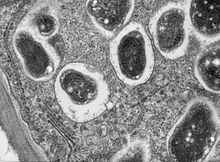
Back نابوت داخلي Arabic Endofitlər Azerbaijani Endofita BS Endòfit Catalan Endofyt Czech Endophyt German Endófito Spanish Endofüüdid Estonian Endofito Basque گیاهدرونرست Persian

An endophyte is an endosymbiont, often a bacterium or fungus, that lives within a plant for at least part of its life cycle without causing apparent disease. Endophytes are ubiquitous and have been found in all species of plants studied to date; however, most of the endophyte/plant relationships are not well understood. Some endophytes may enhance host growth and nutrient acquisition and improve the plant's ability to tolerate abiotic stresses, such as drought, and decrease biotic stresses by enhancing plant resistance to insects, pathogens and herbivores. Although endophytic bacteria and fungi are frequently studied, endophytic archaea are increasingly being considered for their role in plant growth promotion as part of the core microbiome of a plant. [1]
- ^ Chow, Chanelle; Padda, Kiran Preet; Puri, Akshit; Chanway, Chris P. (2022-09-20). "An Archaic Approach to a Modern Issue: Endophytic Archaea for Sustainable Agriculture". Current Microbiology. 79 (11): 322. doi:10.1007/s00284-022-03016-y. ISSN 1432-0991. PMID 36125558. S2CID 252376815.
© MMXXIII Rich X Search. We shall prevail. All rights reserved. Rich X Search